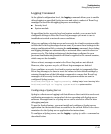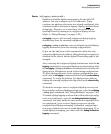
Troubleshooting
Debug/Syslog Operation
Syntax: [no] logging < syslog-ip-addr >
Enables or disables Syslog messaging to the specified IP
address. You can configure up to six addresses. If you
configure an address when none are already configured, this
command enables destination logging (Syslog) and
the Event
debug type. Therefore, at a minimum, the switch begins
sending Event Log messages to configured Syslog servers.
(Refer to “Debug Messages” on page C-38.)
no logging removes all currently configured Syslog logging
destinations from the running configuration.
no logging < syslog-ip-address > removes only the specified Syslog
logging destination from the running configuration.
If you use the “no” form of the command to delete the only
remaining Syslog server address, debug destination logging is
disabled on the switch, but the default Event debug type is not
changed.
Also, removing all configured Syslog destinations with the no
logging command (or a specified Syslog server destination with
the no logging < syslog-ip-address > command) does not delete the
Syslog server IP addresses stored in the startup configuration.
To delete Syslog addresses in the startup configuration, you
must enter a no logging command followed by the write memory
command. To verify the deletion of a Syslog server address,
display the startup configuration by entering the show config
command.
To block the messages sent to configured Syslog servers from
the currently configured debug message type, enter the no debug
< debug-type > command. (See “Debug Messages” on page C-38.)
To disable Syslog logging on the switch without deleting config-
ured server addresses, enter the no debug destination logging
command. Note that, unlike the case in which no Syslog servers
are configured, if one or more Syslog servers are already
configured and Syslog messaging is disabled, configuring a
new server address does not re-enable Syslog messaging. To re-
enable Syslog messaging, you must enter the debug destination
logging command.
C-43


















